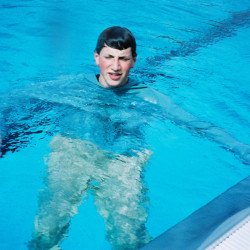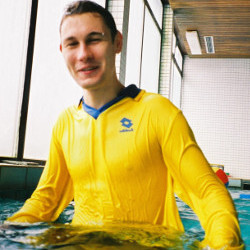Clothes for Survival Swimming and Rescue Training
We are often asked what clothes are best for lifesaving or pool training. The tips in this section are designed to help you find the right kit.
Training Realism
Clothes add greater realism to your swimming and lifesaving practice, while building up your strength and confidence. This also makes your lessons more interesting and a lot more fun. You should be somewhat comfortable with swimming in clothes because you will adjust the intensity of your exercise with the amount of clothing you wear in the water.
Swim coaches like to talk about how swimming is harder in clothes, due to an increase in drag. Swimmers could reduce the impact of increased drag with better skills or with more muscle strength. They may find it difficult to apply more muscle strength to the water if they don't do it the right way. Swimming in clothes forces you to do a skill right or you go nowhere.
Safe Clothing Colours
Light blue swim clothes make you almost invisible in the pool. The contrast is too low. Lifeguards may not see you and other swimmers may bump into you.
Consider swimwear in bright colours so you can be seen. Most swimwear on the market is black or blue. A bright red or yellow anorak worn on top can cheer it up and provide a stronger workout as you have to swim against more resistance.

Light blue swim clothes make you almost invisible in a pool.

Be seen in bright colours.
Learn to Swim in Clothes
Swimming in clothes may be an obvious training element, but is often ignored by many swimming clubs, leaving members unprepared.
This is usually the most popular session among advanced swim teams, intended for competent swimmers. Lifeguard teams learn to swim well in their uniforms and use clothes as rescue and towing aids. If regularly practised it combines strength and stamina with variety and fun.
Teachers lead by example and demonstrate how different clothes influence your swimming ability. You'll learn how heavy wet clothes really get and how that affects your swimming skills, a key to aquatic survival. The more clothing layers you wear in the water, the harder your training gets. This builds strength and prepares you for an actual emergency situation.
Watersports
Be it sailing, canoeing, kite surfing or adventure racing, you wouldn't do it only in swim briefs or bikini. Swimming in clothes is an essential skill for most water sports because a good soaking is often part of their appeal.
When your boat capsizes, or you fall in, or you decide to go for a spontaneous swim,
voluntarily or not, you want to be prepared.
While safety precautions should be taken,
the nature of adventure sports recommends that you wear attire that reduces the possibility of mishap.
Keep Warm
Your clothing protects you from wind, sunburn, cuts and bruises. Which clothes you'll need depends on the weather and what sport you're training for, unless you swim in clothes just for fun.
Dress for immersion, not the air temperature. Clothes are meant to keep you warm. This also holds true in the water, up to a point. T-shirt, jeans and hoodie might be fun for resistance swim training, but cotton can seriously chill you out over time. It holds on to a lot of water which cools you as it evaporates.
Functional fibres like fleece keep you warm even when wet. You're more comfortable in the water when you dress warm enough in comfy clothes.
It may be quite a challenge to swim several lengths fully clothed,
but it is healthy fun and gets you strong over time.
Try a variety of outfits to gain confidence in the water.
Once you're good at swimming in your adventure clothes and
you have achieved an adequate level of confidence,
keep it up to stay fit.
Are Clothes Heavy in Water?
Not really. Clothes weigh very little in water. Throw an item of clothing into a swimming pool and notice how slowly it sinks, if at all. Pull it out of the pool and it gets heavy with all the water it soaked up. Cotton and fleece soaks up more than unlined nylon rainwear.
Don't Confuse Slow Down with Weigh Down
Many people who haven't tried swimming fully clothed, wrongly think they get pulled down by the weight of wet clothes. But that only happens when you come OUT of the water.
When you wear your clothes in the water, they just float around you. The soaked up water only displaces water which would have been there anyway. Water weighs nothing in water, so they only weigh you down by their DRY weight, minus the weight of water displaced by the fabric.
However, the water that's soaked up by the fabric, or collects inside your clothes, will slow down your movements.
This makes it harder on your muscles to move you forward and thus improves training results.
Weigh and Measure Wet and Dry
This experiment will show you how clothes affect your movements and weight in the water. Although your clothes won't pull you down, they will resist your movements and give you a hard workout. One litre of water weighs one kilogram.
- First weigh yourself without any clothes on. Write it down.
- Next get fully dressed in jeans or sweatpants, T-shirt, a hooded sweatshirt,
and possibly a pair of lightweight sports shoes and socks.
The difference in weight with clothes on should be 2 or 3 kg. Write it down.
- Now hop into the water.
Stay in for a while to make sure you get everything fully soaked,
so we can check the weight difference.
Cotton garments soak up a lot of water.
- As soon as you come out of the water, weigh yourself again while still shiny wet.
The difference in weight compared to wearing no clothes should be about 4 to 8 kg, depending on your size.
So the water in your clothes weighs between 2 and 5 kg, about 2 and 5 litres. About half of it runs off in a few minutes.
- Now that you have an idea how much weight is involved you can start your power training.
Do a few push-ups or sit-ups on the pool side. Compare the effort in dry clothes and wet clothes.
Next climb out and jump in as often as you can in one minute. This may sound trivial, but you'll soon find out that it can be quite tough.
